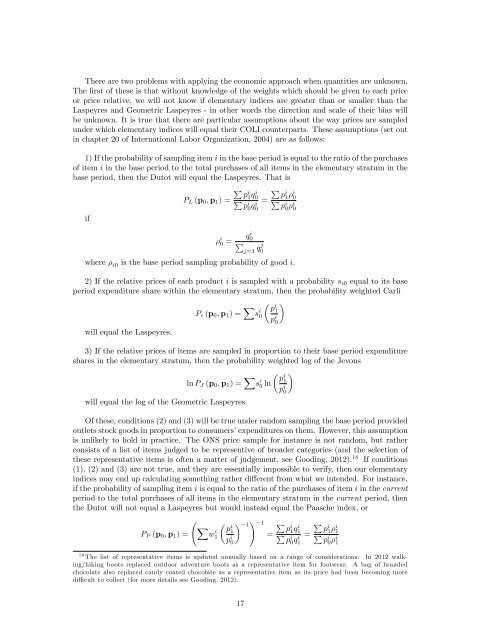Download full version (PDF 311 KB) - The Institute For Fiscal Studies
Download full version (PDF 311 KB) - The Institute For Fiscal Studies
Download full version (PDF 311 KB) - The Institute For Fiscal Studies
You also want an ePaper? Increase the reach of your titles
YUMPU automatically turns print PDFs into web optimized ePapers that Google loves.
<strong>The</strong>re are two problems with applying the economic approach when quantities are unknown.<strong>The</strong> first of these is that without knowledge of the weights which should be given to each priceor price relative, we will not know if elementary indices are greater than or smaller than theLaspeyres and Geometric Laspeyres - in other words the direction and scale of their bias willbe unknown. It is true that there are particular assumptions about the way prices are sampledunder which elementary indices will equal their COLI counterparts. <strong>The</strong>se assumptions (set outin chapter 20 of International Labor Organization, 2004) are as follows:1) If the probability of sampling item i in the base period is equal to the ratio of the purchasesof item i in the base period to the total purchases of all items in the elementary stratum in thebase period, then the Dutot will equal the Laspeyres. That isP piP L (p 0 , p 1 ) = 1 q0P i pi0 q0iP pi= 1 ρ i 0P pi0 ρ i 0ifρ i 0 =q0i Pj=1 qj 0where ρ i0 is the base period sampling probability of good i.2) If the relative prices of each product i is sampled with a probability s i0 equal to its baseperiod expenditure share within the elementary stratum, then the probability weighted Carli pi1will equal the Laspeyres.P c (p 0 , p 1 ) = X s i 0p i 03) If the relative prices of items are sampled in proportion to their base period expenditureshares in the elementary stratum, then the probability weighted log of the Jevonsln P J (p 0 , p 1 ) = X ps i i0 ln 1will equal the log of the Geometric Laspeyres.Of these, conditions (2) and (3) will be true under random sampling the base period providedoutlets stock goods in proportion to consumers’expenditures on them. However, this assumptionis unlikely to hold in practice. <strong>The</strong> ONS price sample for instance is not random, but ratherconsists of a list of items judged to be representive of broader categories (and the selection ofthese representative items is often a matter of judgement, see Gooding, 2012). 18 If conditions(1), (2) and (3) are not true, and they are essentially impossible to verify, then our elementaryindices may end up calculating something rather different from what we intended. <strong>For</strong> instance,if the probability of sampling item i is equal to the ratio of the purchases of item i in the currentperiod to the total purchases of all items in the elementary stratum in the current period, thenthe Dutot will not equal a Laspeyres but would instead equal the Paasche index, orp i 0P P (p 0 , p 1 ) = X pw1i i −1! −1 P1pip i = 1 q1P i0pi0 q1iP pi= 1 ρ i 1P pi0 ρ i 118 <strong>The</strong> list of representative items is updated annually based on a range of considerations. In 2012 walking/hikingboots replaced outdoor adventure boots as a representative item for footwear. A bag of brandedchocolate also replaced candy coated chocolate as a representative item as its price had been becoming morediffi cult to collect (for more details see Gooding, 2012).17
















